Leave No Trace with Little Ones
- Blog Leave No Trace with Little Ones
Created in partnership with 
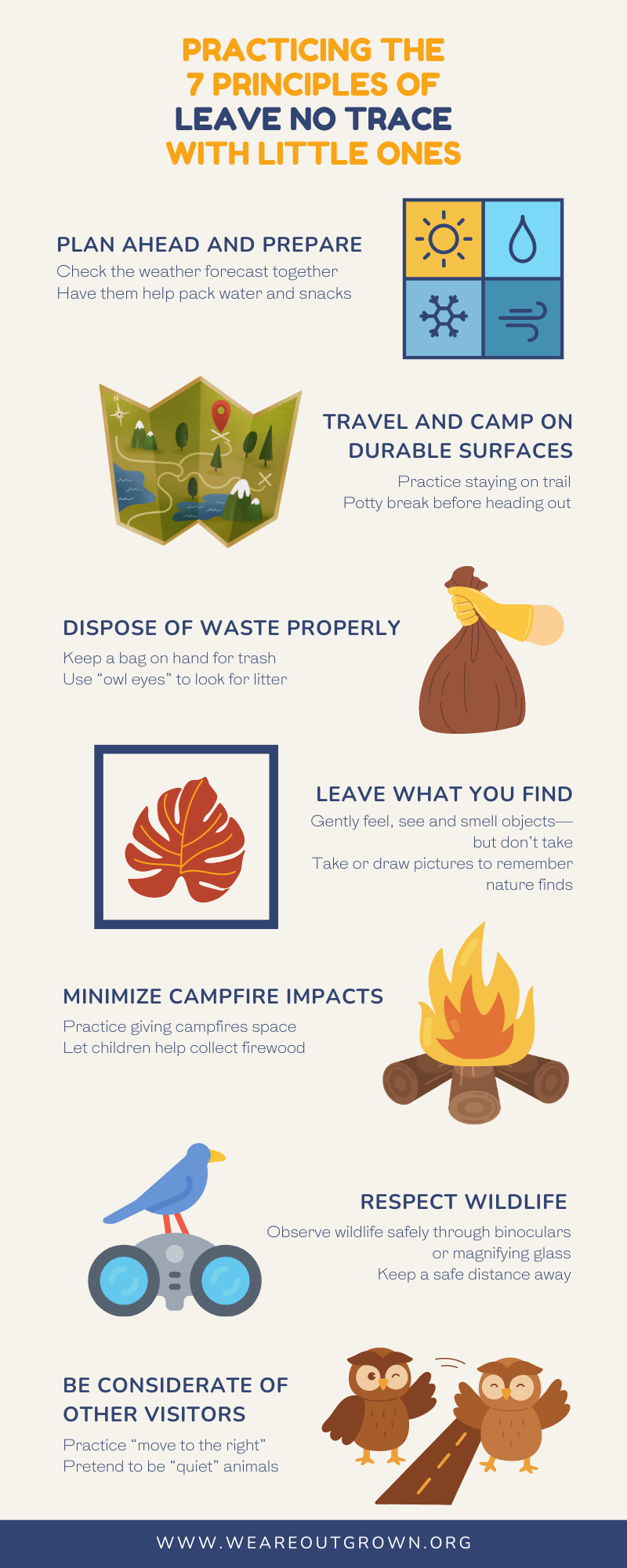 You may have heard about the Leave No Trace movement, but what does it mean to “Leave No Trace”? Is that even possible when you have kids in tow? The answer is yes, sort of.
You may have heard about the Leave No Trace movement, but what does it mean to “Leave No Trace”? Is that even possible when you have kids in tow? The answer is yes, sort of.
The mission of Leave No Trace is to educate and inspire everyone to protect the outdoors by teaching people to enjoy the outdoors responsibly. It isn’t about leaving zero trace; it’s about reducing our environmental impacts whenever and however possible.
That may seem like a daunting task when you are attempting to wrangle a toddler on a trail, but we are here to help! We have listed each principle below along with some tips and tricks for following them when you have little ones in tow.
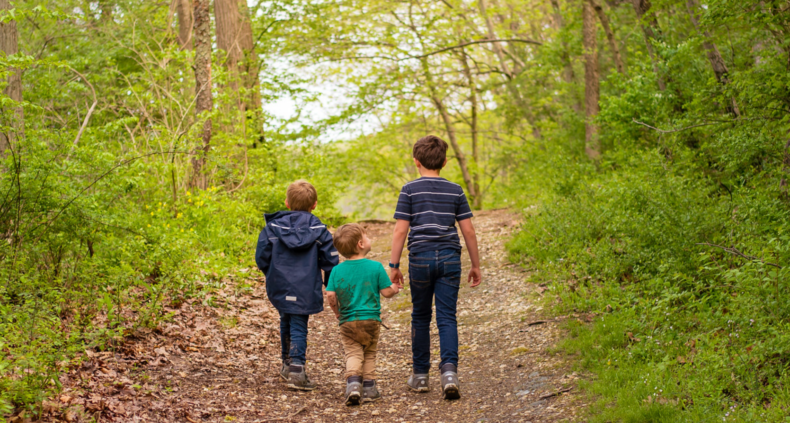
Photo by Jessica Human
Principle 1: Plan Ahead and Prepare – Know Before You Go
Getting lost on the trail or getting caught in a storm while hiking can be a stressful experience. Add in a few little ones to the equation and things can get downright harrowing. While these experiences aren’t always avoidable (like an unexpected rainstorm), a little planning ahead can help you avoid most of these stressful experiences. Here are some tips to involve your kiddos in this step:
- Have your kids check the weather forecast with you and help them decide what clothing they should wear.
- Look at a trail map with your kiddos (a paper map, an online map, or a phone app) and decide together which route you want to take.
- If they are old enough, let them pick out their own snacks to bring along.
- Older kiddos can pack their own adventure pack to take along with things like a snack, water, and adventure tools (like a journal and a pocket microscope).
Principle 2: Travel and Camp on Durable Surfaces – Stay on the Trail
Keeping kiddos on the trail can be challenging. They are natural explorers and want to investigate every little thing they discover. However, exploring off trail can lead to trampled vegetation, increased erosion, and damaged animal habitats. A durable surface includes established trails and campsites along with areas with rock, sand, gravel, snow, and dry grass. If you need to go off trail (like for potty breaks that just can’t wait), seek out these durable surfaces whenever possible, and walk lightly avoiding as much vegetation as possible. Here are some tips for keeping kiddos on the trail and decreasing your impact on the trail.
- Take a potty break as soon as you get to the trail to reduce the number of off-trail excursions.
- Play silly games with kiddos with the main goal of staying on the trail. For example, you can pretend that the vegetation on either side of the trail is lava, and they have to stay as close to the center of the trail as possible to avoid the heat.
- You can also play the “ninja” (sometimes referred to as “secret spy”) game where kids have to step as lightly and quietly as possible and disturb as little as they can to avoid “detection”.
- Have a conversation with your kids about what happens when a lot of people go off trail. Point out signs of erosion and destroyed vegetation along the trail.
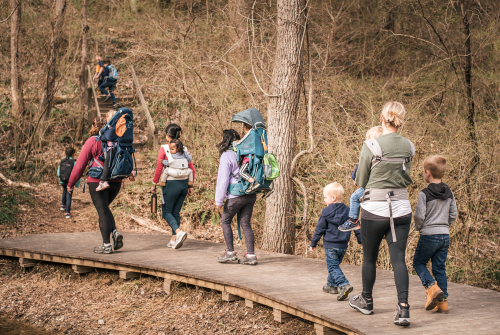
Photo by Jessica Human
Principle 3: Dispose of Waste Properly – Pack it in, Pack it Out
Kids are messy creatures. Aside from their affinity for mud puddles, there are also spilled snacks and the occasional diaper explosion. It’s a good thing to remember that anything that wasn’t found in nature (like the mud) should be packed out. This includes spilled snacks. It may seem harmless, but those snacks usually end up in the stomachs of wildlife. This can lead to illness (I doubt any animals have fishy crackers as part of their natural diet) and increased dependency on humans. Once animals depend more on humans, they lose their fear of humans, which can be dangerous for both them and us. Here are some tips for disposing of waste properly with kiddos in tow.
- Always have a bag on hand to collect your trash (and any other trash you may find) along the way. This could be as simple as a plastic grocery bag or a specific reusable trash bag.
- Anytime you stop for a snack or meal break, have everyone use their “owl eyes” to find any trash left behind before you head back out.
Principle 4: Leave What You Find
This is another tricky principle to follow with little ones. Especially if you have a rock collector like I do! While taking natural objects, picking flowers, carving on trees, etc. may seem harmless, it can damage the ecosystem, especially when a lot of people are doing it. Rocks, sticks, flowers, and even pine cones serve as shelter and food sources for a variety of organisms. If the plant you pick happens to be invasive to the area, you could be inadvertently spreading the species as you transport it. That being said, you don’t want to stifle the curiosity of a budding geologist or botanist. Here are some tips and alternatives for keeping your nature collector happy while leaving nature in nature (or at least most of it):
- Use “do” language to help little ones understand how to interact with nature. Use statements like “let’s be nice with the flowers” or “touch softly”.
- Encourage your kiddos to use their senses to experience the object IN nature. For example, let them take a few minutes to feel, see, and even smell the object. You can talk about it and then have them replace the object where they found it.
- Take along some paper and crayons to they can do some leaf or bark rubbings.
- Have them draw a picture or take a photo of the object.
- When all else fails, allow them to choose one or two favorite nature finds to take home and replace the rest where they found them.
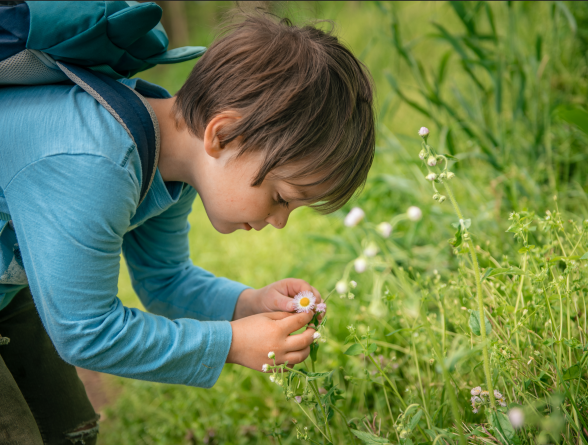
Photo by Jessica Human
Principle 5: Minimize Campfire Impacts
Improperly tended campfires are one of the leading unnatural causes of wildfires. If you are camping be sure you know the local regulations on fire and seek out established fire rings when possible. If you need to gather wood, use dead and downed wood that is no larger than the diameter of your wrist and can be broken easily by hand. When leaving, douse the fire with water until it’s cool to the touch. A better alternative would be to use a camp stove for heat and cooking, or a simple lantern for light. Here are a few tips for minimizing campfire impacts with kiddos:
- Keep flammable objects far away and out of reach from curious hands, and don’t allow kids to play with sticks near the fire.
- Have children help collect firewood. You can make it a game to see who can be the first to find 5 pieces of dry, downed firewood no larger than the diameter of their wrist.
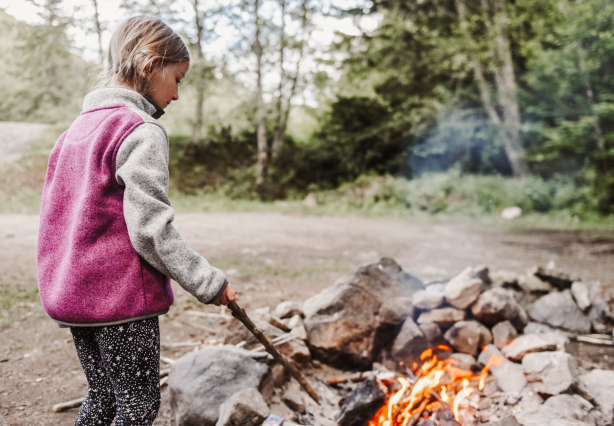
Photo by Deanna Curry
Principle 6: Respect Wildlife
Observing animals in the wild is fascinating for both adults and kids alike. Whether you see a deer dash across the trail ahead of you or a woodpecker busily searching for food, there’s just something awe-inspiring about watching wildlife. To keep having these encounters safely, we need to teach our little ones how to respect wildlife. That means keeping a safe distance, never feeding wild animals, and storing food and odorous objects securely while camping. Here are some tips for teaching our kiddos to respect the animals they encounter on their outdoor adventures and to keep the wildlife wild.
- To help young ones understand what it means to keep a “safe distance”, have them stand with an arm raised to shoulder height with their thumb pointing up. Then have them look at the animal with one eye closed and try to cover it with their thumb. If they are a safe distance away, their thumb should completely block sight of the animal.
- Remind your kids that insects are wildlife too, and we need to be careful not to harm them. We can admire an intricate spider web or a long line of ants without destroying what we find.
- Bring along some adventure items such as binoculars and a magnifying glass so that kiddos can observe wildlife safely.
- Contrary to popular belief, bird feeders can follow the Leave No Trace Principles IF they follow the Audubon Society Guidelines. These include avoiding seed mixtures and cleaning the bird feeders at least every season. If you want to attract a variety of bird species, it is best to have different bird feeders at different heights with different types of seed/food in each of them.
Principle 7: Be Considerate of Other Visitors
Respecting other people you meet on the trail helps ensure that nature can be enjoyed by all. Modeling and encouraging behaviors such as staying to the right on the trail to let others pass or taking breaks on durable surfaces away from the trail goes a long way to preserving the experience for other visitors. Other good practices include avoiding talking on cell phones or making excessively loud noises while on the trail (when possible). Here are a few tips we use to encourage being kind to others on the trail:
- If your kids are like mine, they like to pretend to be wild animals when they are on the trail (particularly howling wolves). This can get extremely noisy, so I started challenging them to be quieter animals, such as a bunny or squirrel, or pretend that they are sneaking around like a cheetah.
- Practice “moving to the right” with your kids while on the trail or on a neighborhood walk. When you practice ahead of time, it can avoid confusion when you ask them to move to the right to let other people or cyclists pass on the trail.
It is important to note that these principles are GUIDELINES, not strict rules. As parents, we know that it is extremely unlikely that we will be perfect at following these principles all the time, and that’s okay! The point is not to strive for perfection all the time. It’s to decrease our impact on the environment whenever and wherever possible and to teach our children to do the same. The tips above can help your family make fewer environmental impacts. You can also check out these other fun resources from Leave No Trace to help your kiddos understand the impact their actions can make on the environment:
Fun Resources from our friends at  :
:
- Learn the Leave No Trace Hand Motions to help kiddos remember the 7 principles.
- Check out the Leave No Trace and Bigfoot Activity Booklet for some fun, education activities for older kids.
- This Trash Timeline Game can be played with kids (and adults) of all ages.
- Here is a free Online Awareness Course for parents and caregivers who want to learn more about Leave No Trace.
How do you practice the Leave No Trace Principles with your family? Let us know in the comments below!
ABOUT OUTGROWN
OutGrown is a 501(c)(3) nonprofit that works to create a world where everyone can enjoy the physical and mental benefits of spending time outside. We are focused on creating opportunities and removing barriers to access so families with babies and young children can take their first steps outside. We believe all families have the right to connect with nature, benefit from spending time outdoors and be inspired to a lifelong love of nature. Since its grassroots inception in 2013, OutGrown is a growing community of 280,000 families and over 300 volunteer Branch Ambassadors. More information on all of our programs can be found at WeAreOutGrown.org
EDITORS NOTE:
We hope you enjoyed reading this article from OutGrown. We’re working hard to provide our community with content and resources that inform, inspire, and entertain you.
But content is not free. It’s built on the hard work and dedication of writers, editors, and volunteers. We make an investment in developing premium content to make it easier for families with young children to connect with nature and each other. We do not ask this lightly, but if you can, please make a contribution and help us extend our reach.


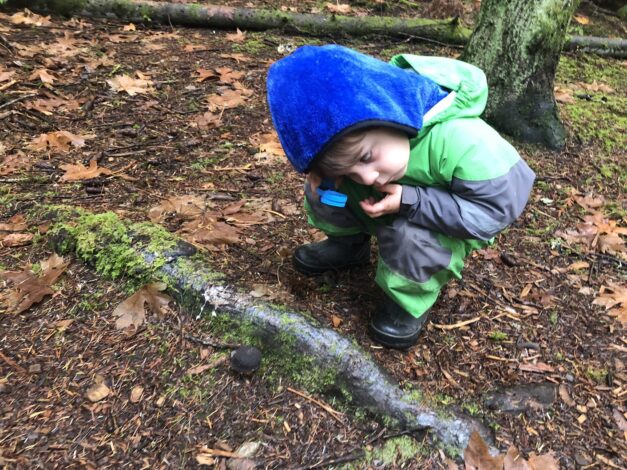


Comments